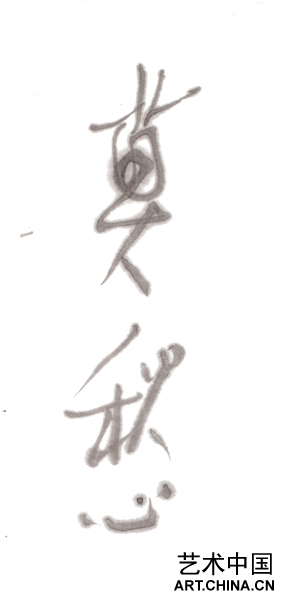|

2008年10月20日
莫愁——邱志杰近作
展览时间:2008年10月25日至12月6日
开幕式:2008年10月25日,下午3-5点
北京前波画廊很荣幸地宣布邱志杰的展览《莫愁》将于2008年10月25日开幕,这是继2006年纽约前波画廊《时间的形状》展览之后邱志杰在前波画廊的第二次个展。本次展览的现场装置以及一系列最新创作的木刻、纸本水墨延续了艺术家进行中的对南京(尤其是南京长江大桥)的研究计划。
近年来,邱志杰关注的项目都需要高密度的考察、取证,并制作跨媒介的作品。从他参加的初期的长征计划开始,到他追寻印度著名探险家Nain Singh足迹的漫长的拉萨-加德满都之行,以及目前他对南京这座城市的深入探索,邱志杰开始着手于更宏大的文化之旅,从中调查同今日生活紧密相关的中国历史文化的诸多方面。迄今为止其最为宏大的是《南京长江大桥自杀现象干预计划》——一个涉足文献、调研与社会活动的项目(在此案例里,他同一支自杀干预小组合作),以多种媒体创作艺术作品。《莫愁》亦是邱志杰总体艺术创作的一部分,虽然表达上较为含蓄。
邱志杰同南京的关系始于2005年,当时他策划了《未来考古学——第二届南京三年展》。2007年的半年里,他开始关注南京长江大桥,尤其是这雄伟的符号与当地高发的自杀率之间的关系。其调研和文献最终孕育了大范围的艺术创作,包括在新加坡泰勒版画学院创作的一批限量版的版画和单件的纸本作品以及包括《莫愁》在内的现场装置。
此次北京前波画廊的装置缘出一件石板画,其基于莫愁湖的传说——清代一名贫穷的姑娘卖身葬父的故事。婚姻的不幸使之投湖自尽,而今日作为的南京旅游名胜的这座湖也因此得名。
邱志杰本次装置的核心是一件硕大的、晶体形状的抽象雕塑。雕塑本是一座太湖石,而其自然原生的形态尽被艺术家切割而去。切下的石块被置于画廊墙面。盲人可经由周围的盲道摸索这些石块从而感知这个展览,另一边有喷泉落于此雕塑,以期用流水使之蜕变回一块太湖石。同时展出的还有一批木刻和纸本水墨,作为邱志杰作品里神秘、萦绕不散的意象的进一步的变体。通过对长江大桥——这座崛起的中国的象征以及如莫愁湖这样典故的关注,邱志杰探索着时间、记忆、命运等主题,此乃其创作的核心所在,无论他的兴趣在于何种媒介。
October 20, 2008
Mochou
Recent Works by Qiu Zhijie
October 25 through December 6, 2008
Opening reception: Saturday, October 25, 3-5pm
Chambers Fine Art Beijing is pleased to announce the opening on October 25, 2008 of Mochou by Qiu Zhijie, his second exhibition at the gallery following The Shape of Time: Light Calli-photography by Qiu Zhijie at Chambers Fine Art New York in 2006. The installation and a new series of woodcuts and ink drawings on paper are associated with the artist’s ongoing investigation of the history of Nanjing and in particular the Nanjing Yangtze River Bridge, inaugurated in 1968 and regarded as a great triumph of Chinese power and resourcefulness.
In recent years Qiu Zhijie has been focusing on projects that require extensive travel and documentation in association with the production of works of art in a variety of media. Beginning with his association with the first phase of the Long March Project, continuing with his epic journey from Lhasa to Khatmandu in the footsteps of Nain Singh and now with his deep involvement with the city of Nanjing, Qiu Zhijie has embarked on an ambitious cultural voyage, investigating aspects of Chinese history and culture as they impinge on life today. Most ambitious by far is A Suicidology of the Nanjing Yangtze River Bridge, the title for an ongoing project involving documentation, research and social activism (in this case, working with a suicide-prevention squad) in association with the production of works of art in many media. Mochou is affiliated with Qiu Zhijie’s gesamtkunstwerk though in an indirect way.
His association with Nanjing began in 2005 when he curated Archaeology of the Future, the second Nanjing Triennial. From the second half of 2007, he began to focus on the Nanjing Yangtze River Bridge and in particular the relationship between this potent symbol and the high rate of suicides that occur there. Research and documentation led to a wide range of artistic productions, including a group of editioned prints and unique works on paper made at Singapore Tyler Print Institute and independent installations such as Mochou.
Related to one of the lithographs, the installation at Chambers Fine Art Beijing is based on the legend of Mochou, a young girl who lived in the Qin Dynasty, who was so poor that she had to sell herself to pay for her father’s funeral. Deeply unhappy in her marriage, she committed suicide in the lake that now bears her name and is one of the most popular tourist destinations in Nanjing.
The central feature of Qiu Zhijie’s installation is a large, crystalline abstract sculpture, originally a scholar’s rock from which all the naturally formed projections have been sliced off. These are attached to the wall of the gallery. A path for the blind enables the visually impaired to touch the rocks and feel their way around the gallery while a stream of water trickles down the abstract sculpture, beginning the process that will eventually return it to its original form as a scholar’s rock. Accompanying the installation is a new series of woodcuts and ink drawings on paper, further variations on Qiu Zhijie’s haunting and mysterious imagery. By focusing on the bridge which is such a potent symbol of China’s emerging power and related themes from China’s past such as Mochou, Qiu Zhijie explores themes such as time, memory and destiny, issues that have always been central to his interests in whatever medium he worked.
|

